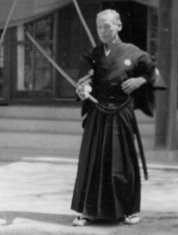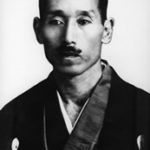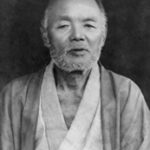Tatsumi Ryu (Sakura Line)

22nd (present) Headmaster: Kato Hiroshi (1944 – )
Born in the then Japanese occupied Taiwan. From an early age, studied Tatsumi ryu and Kendo under his father, Kato Takashi, 21st Headmaster, and Nagano Sensei and Oki Sensei, both Menkyo Kaiden in Tatsumi ryu.
Received Menkyo Kaiden in Tatsumi ryu in 1981. Recognised as an Intangible Cultural Asset by Chiba Prefecture. Works as a lawyer in Chiba City.

21st Headmaster: Kato Takashi (1913 – 2004)
Second son of Kato Hisashi, the 19th Headmaster. From an early age, studied Tatsumi ryu and Kendo under his father, Hisashi. Graduate of Sakura Chugakko (now Sakura High School), and Kokushikan Senmon Gakko (now Kokushikan University). He majored in Kendo and Classical Japanese language.
He studied various Budo under such legendary figures as Nakayama Hakudo, Takano Sasaburo, Mochida Seiji (Kendo) and Saimura Goro (Kendo), Yamashita Yoshiaki (Judo), and Jikita Osamu. Awarded Kendo 5th dan (then the highest dan rank) Renshi and Iai-jutsu 5th dan Renshi by the Dai Nippon Butokukai in 1937. He was the youngest person to be awarded Iai-jutsu Renshi.
Became Headmaster on the death of his older brother, Sadao. Zenkenren Iaido Hanshi, Kendo Kyoshi, President of the Nihon Kobudo Shinkokai, Board Member of the Nippon Kobudo Kyokai. Recognised as an Intangible Cultural Asset by Chiba Prefecture.

20th Headmaster: Kato Sadao (1910 – 1984)
First son of Kato Hisashi, the 19th Headmaster. From an early age, studiedTatsumi ryu and Kendo under his father, as well as Kendo under Mochida Seiji Sensei. Zenkenren Iaido Kyoshi, Kendo Kyoshi. Compared to his brother it was said, “Sadao uses a light sword as if it were heavy, Takashi uses a heavy sword as if it were light.” Recognised as an Intangible Cultural Asset by Chiba Prefecture.

19th Headmaster: Kato Hisashi (1884 – 1949)
Known for his intense dedication to training, he received Menkyo Kaiden in Tatsumi ryu from 18th Headmaster, Hanzawa Naritsune. Hanzawa Sensei then told him “I have taught you all I know. Go to Takano Sasaburo Sensei. You can learn much from him.” Hisashi did so learning Takano Sensei’s Nakanishi-ha Itto ryu, and was promoted to Menkyo Kaiden (full transmission of the style). Another ryu he studied was the Mugai ryu of Sakura. This ryu specialised in swimming in armour and using weapons while swimming. To test his ability, he is said to have swum the Inbanuma when it was in flood wearing full armour.
Hisashi was known as the “Saint of Yatomi.” One example of his integrity and moral as well as physical courage is his saving six Koreans from a lynch mob after the Great Tokyo Earthquake in 1921.
Takano Sasaburo and Nakayama Hakudo, two of the great figures in modern Kendo history, and Mochida Seiji, winner of one of the Tenranjinai, were all mentors of Hisashi Sensei. Hisashi Sensei was awarded the rank of Kyoshi by the Nippon Butokukai for both Kendo and Iai-jutsu. He is the only person in Tatsumi ryu history to have performed 30, 000 repetitions of kazunuki (the two basic iai kata).

18th Headmaster: Hanzawa Naritsune (1835 – 1916)
First son of Hanzawa Kyubei, He studied under Henmi Chuzo, in 1852 at 18 years old, received Tojutsu Tachiai mokuroku, 6 years later, Tojutsu iai mokuroku, in 1856 menkyo at 22, in 1860 ordered by Sakura -han to Edo, studied Kyoshin Meichi ryu at Momonoi Dojo of Momonoi Shunzo and soon became head student. Returned to Sakura-han in1863.
Tatsumi ryu – Influential Figures

Mochida Seiji (1885 – 1974)
One of the great figures in early modern Kendo, winner of the Tenranjiai, and mentor of Kato Hisashi and Kato Takashi.

Henmi Sosuke (1843 – 1895)
First son of Henmi Chuzo. In 1859 at 16 years old, he received Tachi-ai mokuroku. In 1861, Henmi received permission to go to Edo where he studied Kyoshin Meichi ryu at Momonoi Dojo and took part in the mission to Kyoto. After his return, he joined the Tokyo Police and became the first head of the kenjutsu training unit. Like Kato Hisashi, he was an exponent of Mugai ryu,a koryu which taught martial applications of swimming.
Henmi is briefly described in F.J. Norman’s Fighting Man of Japan, first published in 1905 and recently republished, as possibly the best swordsman he had met in Japan. Norman was an ex-officer of the British Army who practised Kendo and taught at some military colleges in Japan. As a career officer trained in Western swordsmanship, he has an interesting perspective, and his words carry some weight.
Henmi Sosuke passed away in 1895.